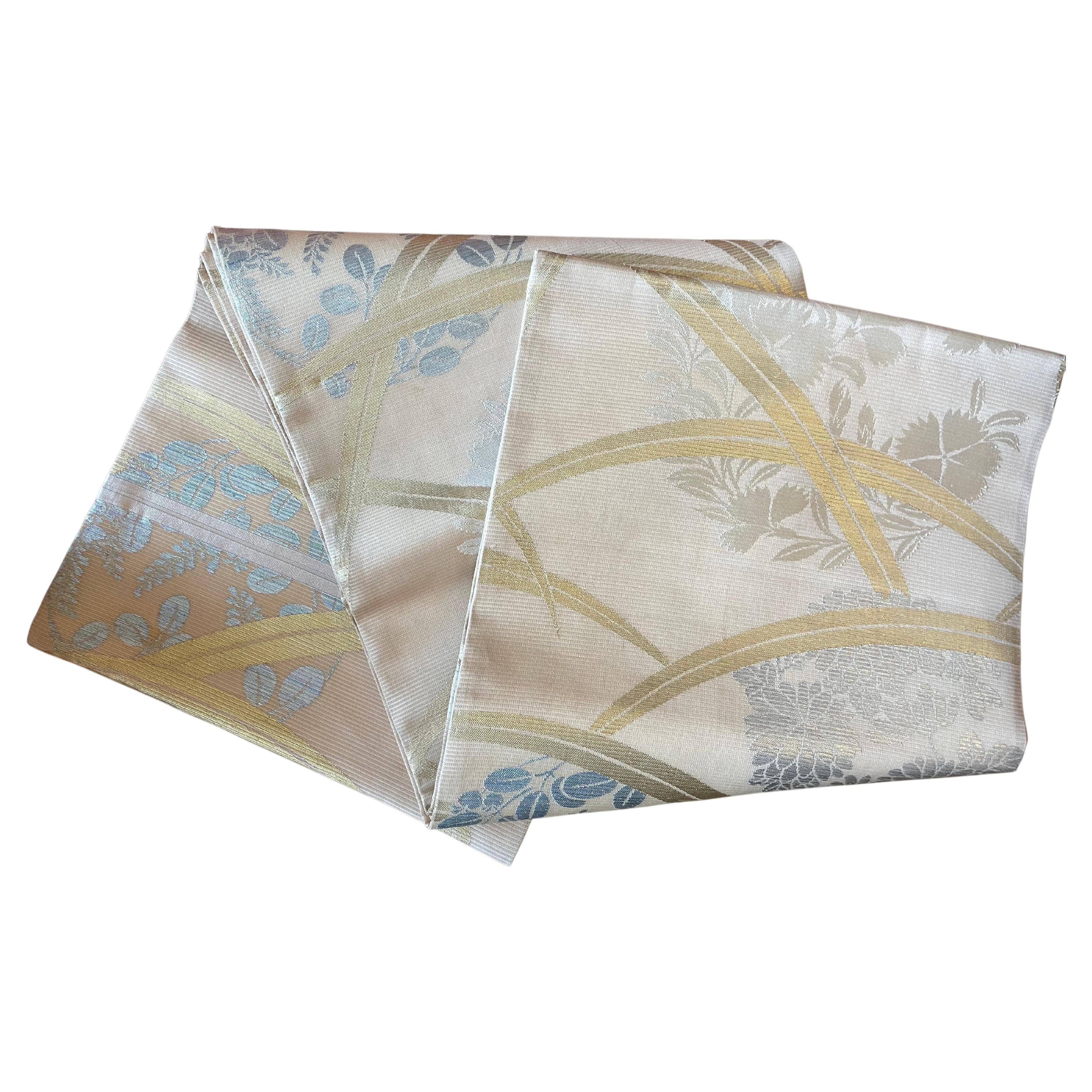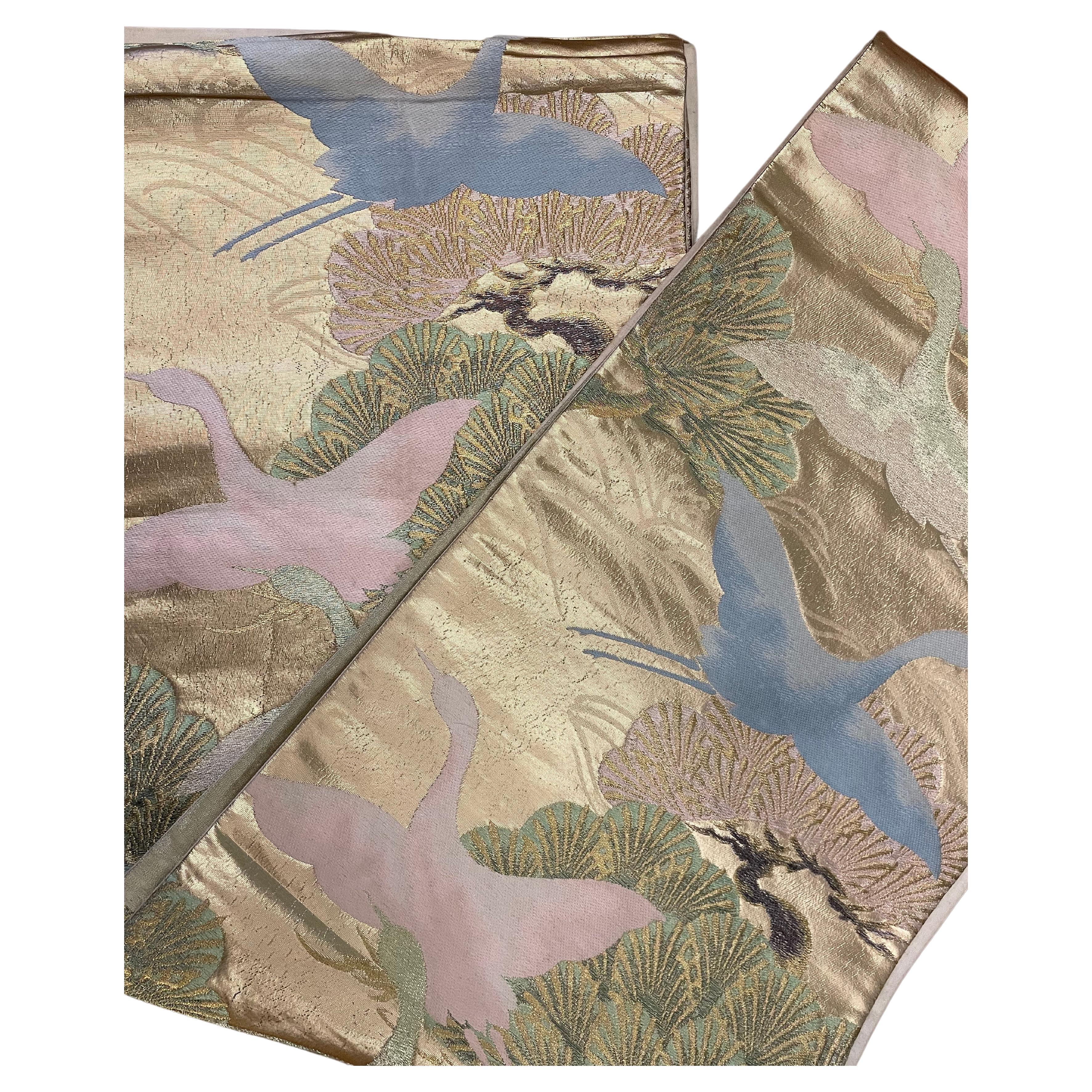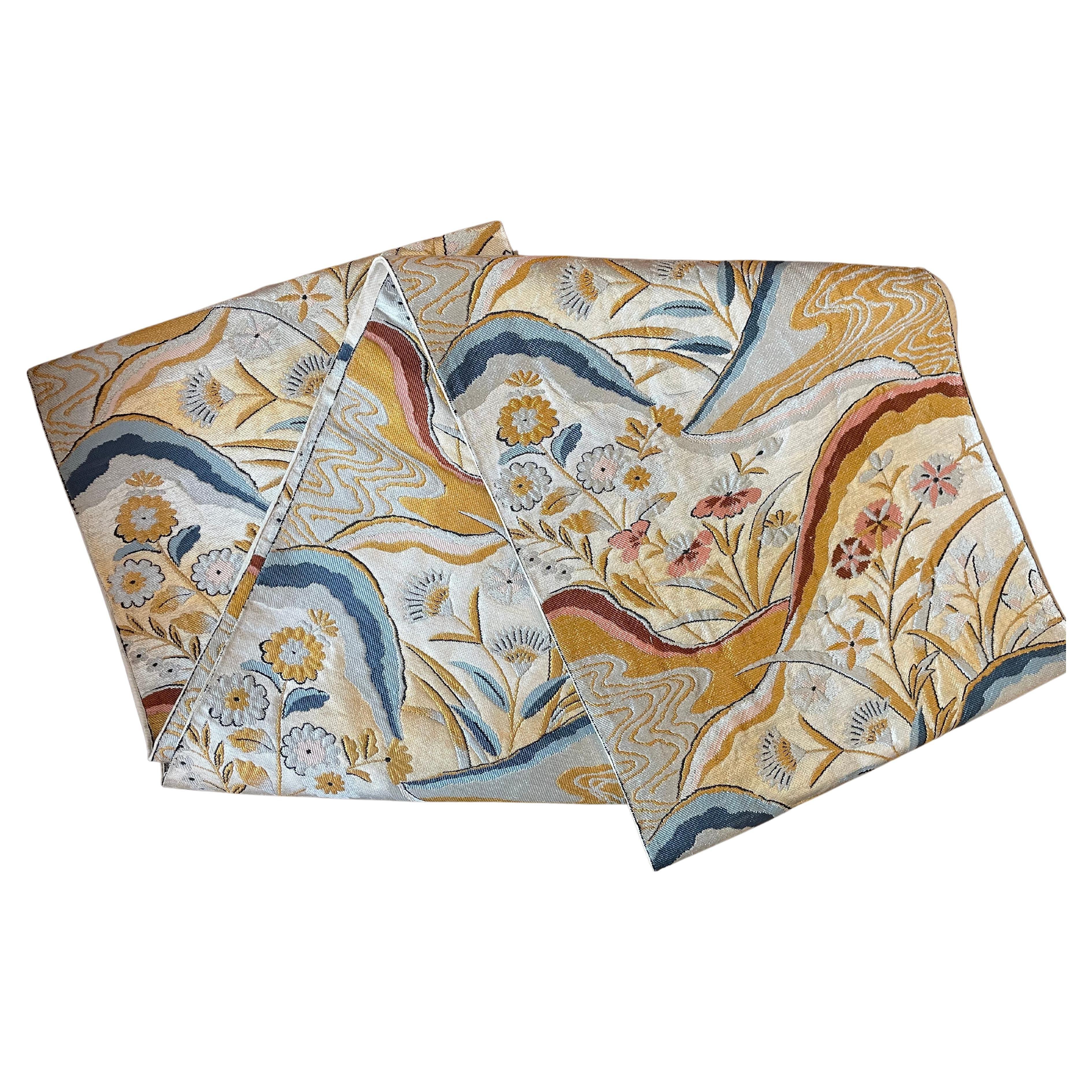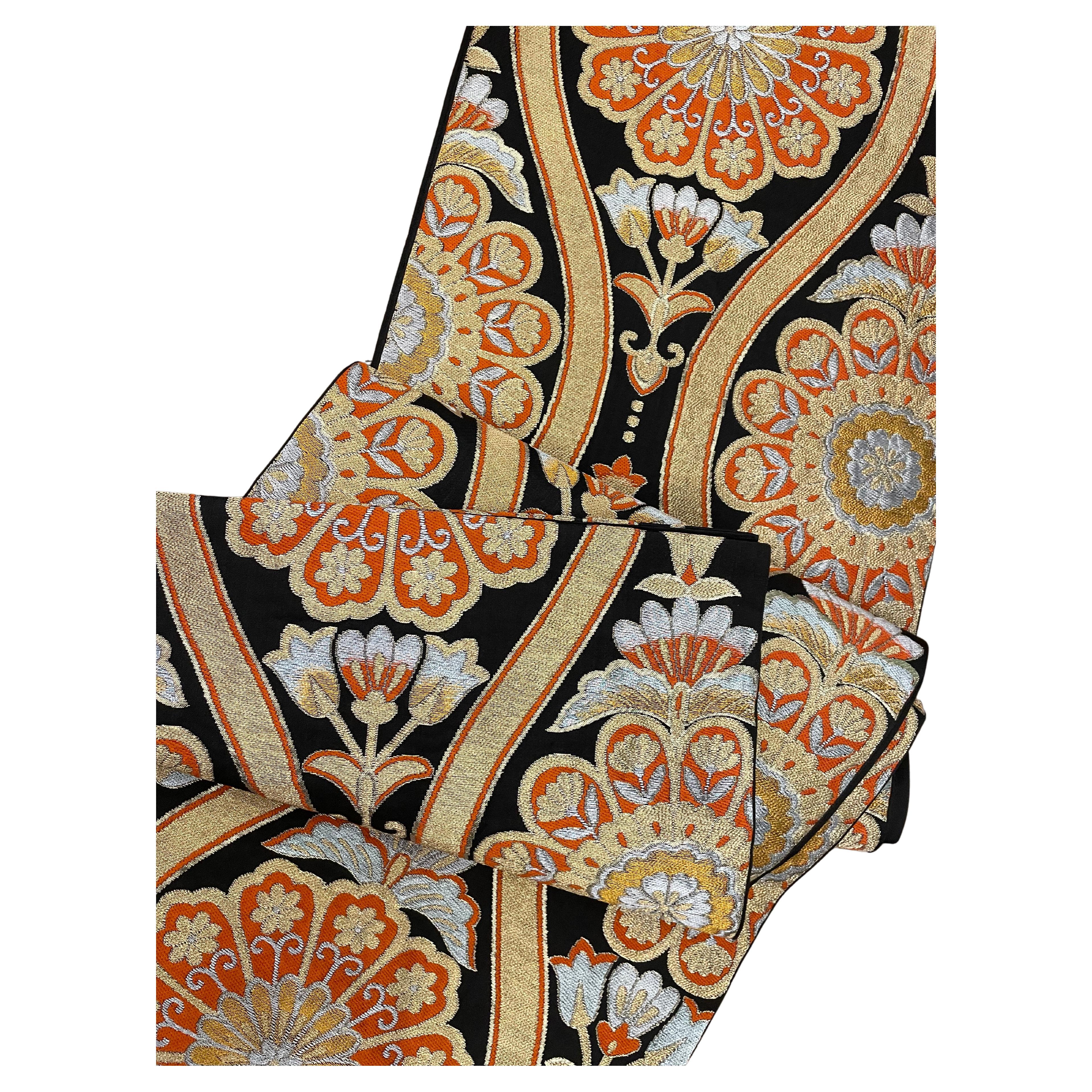Items Similar to Japanese Antique Silk Kimono Belt, 1960s
Want more images or videos?
Request additional images or videos from the seller
1 of 13
Japanese Antique Silk Kimono Belt, 1960s
About the Item
This is a Fukuro Obi made in Japan around 1960s.
It is made with Silk and it is in good condition.
Obi is a belt of varying size and shape worn with both traditional Japanese clothing like Kimono.Obi are categorised by their design, formality, material, and use, and can be made of a number of types of fabric, with heavy brocade weaves worn for formal occasions, and some lightweight silk obi worn for informal occasions.
Fukuro obi are slightly less formal than maru obi, despite being functionally the most formal variety of obi worn today. Fukuro obi are made from either a single double-width length of fabric with a seam down one edge, or from two lengths of fabric sewn together down each edge for fukuro obi made from two lengths of fabric, the fabric used for the backside may be cheaper and appear to be more plain.
Fukuro obi are roughly 30 centimetres (12 in) wide and 360 centimetres (11.8 ft) to 450 centimetres (14.8 ft) long. (Wikipedia)
Dimensions: this obi is 4m20cm (420cm) long and 30.5cm wide.
On the front, fabric is with motifs and on the back it's all white with no motifs.
On the front side of fabrique in the middle, 85cm is with no motif and just white fabric.
- Dimensions:Height: 165.36 in (420 cm)Width: 12.01 in (30.5 cm)Depth: 0.4 in (1 cm)
- Style:Showa (Of the Period)
- Materials and Techniques:
- Place of Origin:
- Period:
- Date of Manufacture:1960
- Condition:This belt is in the good condition but there is some threads which are frayed.
- Seller Location:Paris, FR
- Reference Number:1stDibs: LU6325233826652
About the Seller
No Reviews Yet
Vetted Seller
These experienced sellers undergo a comprehensive evaluation by our team of in-house experts.
1stDibs seller since 2022
23 sales on 1stDibs
Typical response time: 19 hours
- ShippingRetrieving quote...Ships From: Paris, France
- Return PolicyThis item cannot be returned.
More From This SellerView All
- Antique Silk Japanese Kimono Belt, 1970sLocated in Paris, FRThis is a Hitoe Obi made in Japan around 1970s. Obi is a belt of varying size and shape worn with both traditional Japanese clothing like Kimono....Category
Late 20th Century Japanese Showa Antiquities
MaterialsSilk
- Japanese Vintage Kimono Silk Belt Tsuru Birds Fukuro-obi 1960sLocated in Paris, FRThis is a Fukuro Obi made in Japan around 1960s. Obi is a belt of varying size and shape worn with both traditional Japanese clothing like Kimono.Obi are categorised by their desig...Category
Late 20th Century Japanese Showa Antiquities
MaterialsSilk
- Japanese Vintage Kimono Silk Belt Sky blue/ White Fukuro-obi 1960sLocated in Paris, FRThis is a Fukuro Obi made in Japan around 1960s. Obi is a belt of varying size and shape worn with both traditional Japanese clothing like Kimono.Obi are categorised by their design, formality, material, and use, and can be made of a number of types of fabric, with heavy brocade weaves worn for formal occasions, and some lightweight silk obi worn for informal occasions. Fukuro obi are slightly less formal than maru obi...Category
Late 20th Century Japanese Showa Antiquities
MaterialsSilk
- Japanese Yellow Silk Kimono Belt Nagoyaobi 1970sLocated in Paris, FRThis is a Nagoya Obi made in Japan around 1970s. Obi is a belt of varying size and shape worn with both traditional Japanese clothing like Kimono...Category
Late 20th Century Japanese Showa Antiquities
MaterialsSilk
- Japanese Vintage Silk Kimono Belt 1970s FlowersLocated in Paris, FRThis is Obi made in Japan around 1970s. It is made with Silk and it is in good condition. Obi is a belt of varying size and shape worn with both traditional Japanese clothing like...Category
Vintage 1970s Japanese Showa Antiquities
MaterialsSilk
- Japanese Silk Kimono Belt Fukuro-Obi 1970s /Table RunnerLocated in Paris, FRThis is a Fukuro Obi made in Japan around 1970s. It is made with Silk and it is in good condition. Obi is a belt of varying size and shape worn with both traditional Japanese clothing like Kimono.Obi are categorised by their design, formality, material, and use, and can be made of a number of types of fabric, with heavy brocade weaves worn for formal occasions, and some lightweight silk obi worn for informal occasions. Fukuro obi are slightly less formal than maru obi...Category
Late 20th Century Japanese Showa Antiquities
MaterialsSilk
You May Also Like
- Rare Spectacular Hand-Embroidered Silk Japanese KimonoLocated in Brea, CAThis highly collectable spectacular rare kimono has detailed hand-embroidery throughout accented . This ceremonial Japanese kimono is hand sewn and hand-quilted throughout.Category
Early 20th Century Chinese Chinese Export Antiquities
MaterialsSilk
- Japanese Antique Block Wood 1950s-1960s Object Primitive JapandiLocated in Chiba-Shi, JPThis is an old Japanese wood block. I think a square object would be good as an art object or as an exhibition stand to put something on. Weight 7.4 kg We will always suggest the b...Category
Mid-20th Century Japanese Antiquities
MaterialsWood
- Japanese Old Pottery Dog 1940s-1960s / Figurine Sculpture Wabi SabiLocated in Sammu-shi, ChibaThis is an old Japanese ceramic dog. It is a figurine from the mid-Showa period (1940s-1960s). Although unnamed, it has a cute expression and goo...Category
Vintage 1950s Japanese Showa Antiquities
MaterialsPottery
- Japanese Antique Iron Block 1920s-1940s / Object WabisabiLocated in Sammu-shi, ChibaIt is a very old iron block. It is from the early Showa period (1920s-1940s). Weight: approx. 50 kg. It was used as a tool for steel workers. They buried it in the ground and pound...Category
Early 20th Century Japanese Showa Antiquities
MaterialsIron
- Japanese Antique Tree Object 1900s-1940s / Wabi SabiLocated in Sammu-shi, ChibaSince ancient times, people have created and inherited necessary tools from familiar materials to survive in the severe struggle against nature, and have nurtured a lifestyle culture...Category
Mid-20th Century Japanese Showa Antiquities
MaterialsPine
- Japanese Antique Horse Object 1920s-1940s / Figurine Mingei WabisabiLocated in Sammu-shi, ChibaThis is an old Japanese horse figurine. It was made in the early Showa period (1920s-1940s). It is mainly made of paper. (Various materials are used). It is a very elaborate creati...Category
Mid-20th Century Japanese Showa Antiquities
MaterialsPaper
Recently Viewed
View AllMore Ways To Browse
Japanese Antiques
Japanned Antique
Japaneses Antiques
Japan Antiques
Japanes Antiques
Japanese Antiques Furniture
Japanese Clothing
Japanese Used Clothing
Japanese Crafted
Japanese Crafts
1960s Silk
Japanese 1960
Japanese Art And Antiques
Traditional Japanese Furniture
Japanese Fabric
Japanese Motif
White Silk Fabric
Hands Belt





